Anisotropic Wear Resistance of Heat-Treated Selective Laser-Melted 316L Stainless Steel
Abstract
1. Introduction
2. Materials and Methods
2.1. Sample Preparation
2.2. Microstructural Characterization
2.3. Microhardness and Wear Behaviors
3. Results
3.1. Microstructure Characterization
3.2. Density
3.3. Microhardness
3.4. Friction and Wear
4. Conclusions
- XRD analysis of SLM 316L demonstrated a γ austenite phase, and specimens subjected to solution + aging treatment exhibited M23C6 carbides and γ austenite and α ferrite phases. Furthermore, the microstrain was reduced with heat treatment.
- The microstructure of the SLM 316L specimen exhibited intersecting melt pools on the XOY plane and fish scale-like melt pools on the XOZ plane. The melt pools were composed of columnar crystals and cellular crystals due to the rapid solidification characteristic. The anisotropy of microstructures on the XOY and XOZ planes resulted in differences in density and microhardness. Following heat treatment, the melt pool boundaries were eliminated, carbides (M23C6) precipitated at grain boundaries and within the grains, and the microstructures coarsened but became more uniform.
- The finer microstructure of SLM 316L resulted in higher density and microhardness. Compared with SLM 316L, the microhardness decreased after heat treatment, and the density and microhardness of the specimens subjected to solution + aging treatment were the highest among heat-treated specimens.
- The wear resistance of the XOY plane in specimen a is superior to that of the XOZ plane. The specimen subjected to solution + aging treatment exhibited the lowest friction coefficient and wear rate, with the wear track found to be the narrowest and shallowest. The wear rates of specimens of the XOY and XOZ planes after solution + aging treatment were 21.1% and 27.1% lower than that of SLM 316L. The specimen subjected to solution + aging treatment exhibited the best wear resistance due to the lower microstrain and higher microhardness.
Author Contributions
Funding
Data Availability Statement
Conflicts of Interest
References
- Dadkhah, M.; Mosallanejad, M.H.; Iuliano, L.; Saboori, A. A Comprehensive Overview on the Latest Progress in the Additive Manufacturing of Metal Matrix Composites: Potential, Challenges, and Feasible Solutions. Acta Metall. Sin. 2021, 34, 1173–1200. [Google Scholar] [CrossRef]
- Mazyar, A.; Mobin, K.; Ehsan, T. Adaptive Model-based Optimization for Fusion-based Metal Additive Manufacturing (directed energy deposition). J. Manuf. Process. 2023, 108, 588–595. [Google Scholar]
- Song, W.; Yang, J.; Liang, J.; Lu, N.; Zhou, Y.; Sun, X.; Li, J. A New Approach to Design Advanced Superalloys for Additive Manufacturing. Addit. Manuf. 2024, 84, 104098. [Google Scholar] [CrossRef]
- Timothy, M.S.; Christopher, A.K.; Nikolai, A.Z.; Bryan, J.H.; Milan, H.; Paul, R.G.; Aaron, C.T.; Michael, J.M.; Timothy, P.G.; John, W.L. A 3D Printable Alloy Designed for Extreme Environments. Nature 2023, 617, 513–518. [Google Scholar]
- Ataee, A.; Li, Y.; Wen, C. A Comparative Study on the Nanoindentation Behavior, Wear Resistance and in Vitro Biocompatibility of SLM Manufactured CP–Ti and EBM Manufactured Ti64 Gyroid Scaffolds. Acta Biomater. 2019, 97, 587–596. [Google Scholar] [CrossRef] [PubMed]
- Ngo, T.D.; Kashani, A.; Imbalzano, G.; Nguyen, K.T.Q.; Hui, D. Additive Manufacturing (3D printing): A Review of Materials, Methods, Applications and Challenges. Compos. Part B Eng. 2018, 14, 172–196. [Google Scholar] [CrossRef]
- Andac, O.; Eda, A.; Arcan, F.D. Selective Laser Melting of Nano-TiN Reinforced 17-4 PH Stainless Steel: Densification, Microstructure and Mechanical Properties. Mater. Sci. Eng. A 2021, 836, 142574. [Google Scholar]
- Ji, P.C.; Wang, Z.H.; Mu, Y.K.; Jia, Y.D.; Wang, G. Microstructural Evolution of (FeCoNi)85.84Al7.07Ti7.09 High-entropy Alloy Fabricated by an Optimized Selective Laser Melting Process. Mater. Des. 2022, 224, 111326. [Google Scholar] [CrossRef]
- Saeidi, K.; Gao, X.; Lofaj, F.; Kvetková, L.; Shen, Z. Transformation of Austenite to Duplex Austenite-Ferrite Assembly in Annealed Stainless Steel 316L Consolidated by Laser Melting. J. Alloys Compd. 2015, 633, 463–469. [Google Scholar] [CrossRef]
- Abdali, A.; Nedjad, S.H.; Zargari, H.H.; Saboori, A.; Yildiz, M. Predictive Tools for the Cooling Rate-dependent Microstructure Evolution of AISI 316L Stainless Steel in Additive Manufacturing. J. Mater. Res. Technol. 2024, 29, 5530–5538. [Google Scholar] [CrossRef]
- Jabarzadeh, S.; Ghalebahman, G.A.; Najibi, A. Investigation into Microstructure, Mechanical Properties, and Compressive Failure of Functionally Graded Porous Cylinders Fabricated by SLM. Eng. Fail. Anal. 2024, 165, 108794. [Google Scholar] [CrossRef]
- Das, A.; Yadav, V.; AlMangour, B.; Prasad, H.C.; Sathish, N.; Ashiq, M.; Srivastava, A.K. Additive Manufacturing of Graphene Reinforced 316L Stainless Steel Composites with Tailored Microstructure and Mechanical Properties. Mater. Chem. Phys. 2023, 303, 127826. [Google Scholar] [CrossRef]
- Kumar, P.; Jayaraj, R.; Suryawanshi, J.; Satwik, U.; McKinnell, J.; Ramamurty, U. Fatigue Strength of Additively Manufactured 316L Austenitic Stainless Steel. Acta Mater. 2020, 199, 225–239. [Google Scholar] [CrossRef]
- Bakhtiarian, M.; Omidvar, H.; Mashhuriazar, A.; Sajuri, Z.; Gur, C.H. The Effects of SLM Process Parameters on the Relative Density and Hardness of Austenitic Stainless Steel 316L. J. Mater. Res. Technol. 2024, 29, 1616–1629. [Google Scholar] [CrossRef]
- Li, H.; Ramezani, M.; Li, M.; Ma, C.; Wang, J. Effect of Process Parameters on Tribological Performance of 316L Stainless Steel Parts Fabricated by Selective Laser Melting. Manuf. Lett. 2018, 16, 36–39. [Google Scholar] [CrossRef]
- Zhu, Y.; Zou, J.; Chen, X.; Yang, H. Tribology of Selective Laser Melting Processed Parts: Stainless Steel 316L under Lubricated Conditions. Wear 2016, 350–351, 46–55. [Google Scholar] [CrossRef]
- Li, H.; Ramezani, M.; Li, M.; Ma, C.; Wang, J. Tribological performance of selective laser melted 316L stainless steel. Tribol. Int. 2018, 128, 121–129. [Google Scholar] [CrossRef]
- Sun, Y.; Moroz, A.; Alrbaey, K. Sliding Wear Characteristics and Corrosion Behaviour of Selective Laser Melted 316L Stainless Steel. J. Mater. Eng. Perform. 2014, 23, 518–526. [Google Scholar] [CrossRef]
- Smith, W.L.; Roehling, J.D.; Strantza, M.; Ganeriwala, R.K.; Ashby, A.S.; Vrancken, B.; Clausen, B.; Guss, G.M.; Brown, D.W.; McKeown, J.T.; et al. Residual Stress Analysis of in Situ Surface Layer Heating Effects on Laser Powder Bed Ffusion of 316L Stainless Steel. Addit. Manuf. 2021, 37, 102252. [Google Scholar]
- Chepkoech, M.; Owolabi, G.; Warner, G. Investigation of Microstructures and Tensile Properties of 316L Stainless Steel Fabricated via Laser Powder Bed Fusion. Materials 2024, 17, 913. [Google Scholar] [CrossRef]
- Herzog, D.; Seyda, V.; Wycisk, E.; Emmelmann, C. Additive Manufacturing of Metals. Acta Mater. 2016, 117, 371–392. [Google Scholar] [CrossRef]
- Maleki, E.; Unal, O.; Doubrava, M.; Pantelejev, L.; Bagherifard, S.; Guagliano, M. Application of Impact-based and Laser-based Surface Severe Plastic Deformation Methods on Additively Manufactured 316L: Microstructure, Tensile and Fatigue Behaviors. Mater. Sci. Eng. A 2024, 916, 147360. [Google Scholar] [CrossRef]
- Chao, Q.; Thomas, S.; Birbilis, N.; Cizek, P.; Hodgson, P.D.; Fabijanic, D. The Effect of Post-processing Heat Treatment on the Microstructure, Residual Stress and Mechanical Properties of Selective Laser Melted 316L Stainless Steel. Mater. Sci. Eng. A 2021, 821, 1441611. [Google Scholar] [CrossRef]
- Peng, P.; Wang, K.S.; Wang, W.; Han, P.; Zhang, T.; Liu, Q.; Zhang, S.; Wang, H.; Qiao, K.; Liu, J. Relationship between Microstructure and Mechanical Properties of Friction Stir Processed AISI 316L Steel Produced by Selective Laser Melting. Mater. Charact. 2020, 163, 110283. [Google Scholar] [CrossRef]
- Zhang, S.; Jia, M.; Wang, W.; Hou, J.; Kuang, W. The Effects of Heat Treatment and Surface State on the Corrosion Resistance of Laser Powder Bed Fusion 304L Stainless Steel in 3.5 wt% NaCl Solution. J. Mater. Res. Technol. 2024, 29, 5620–5632. [Google Scholar] [CrossRef]
- Kong, D.; Dong, C.; Ni, X.; Zhang, L.; Yao, J.; Man, C.; Cheng, X.; Xiao, K.; Li, X. Mechanical Properties and Corrosion Behavior of Selective Laser Melted 316L Stainless Steel after Different Heat Treatment Processes. J. Mater. Sci. Technol. 2019, 35, 1499–1507. [Google Scholar] [CrossRef]
- Patrik, P.; Tibor, K.; Jana, B.; Bidulský, R.; Grande, M.A.; Manfredi, D.; Weiss, K.-P.; Kočiško, R.; Lupták, M.; Pokornýal, I. Investigation of the Properties of 316L Stainless Steel after AM and Heat Treatment. Materials 2023, 16, 3935. [Google Scholar] [CrossRef] [PubMed]
- Yin, H.S.; Song, M.; Deng, P.; Li, L.; Prorok, B.C.; Lou, X. Thermal Stability and Microstructural Evolution of Additively Manufactured 316L Stainless Steel by Laser Powder Bed Fusion at 500–800 °C. Addit. Manuf. 2021, 41, 101981. [Google Scholar] [CrossRef]
- Shankar, P.; Shaikh, H.; Sivakumar, S.; Venugopal, S.; Sundararaman, D.; Khatak, H. Effect of Thermal Aging on the Room Temperature Tensile Properties of AISI Type 316LN Stainless Steel. J. Nucl. Mater. 1999, 264, 29–34. [Google Scholar] [CrossRef]
- Zhou, B.G.; Xu, P.W.; Li, W.; Liang, Y.L.; Liang, Y. Microstructure and Anisotropy of the Mechanical Properties of 316L Stainless Steel Fabricated by Selective Laser Melting. Metals 2021, 11, 775. [Google Scholar] [CrossRef]
- Yang, Y.; Zhu, Y.; Khonsari, M.; Yang, H. Wear Anisotropy of Selective Laser Melted 316L Stainless Steel. Wear 2019, 428–429, 376–386. [Google Scholar] [CrossRef]
- ASTM A666; Annealed or Cold-Worked Austenitic Stainless Steel Sheet, Strip, Plate, and Flat Bar. ASTM International: West Conshohocken, PA, USA, 2010.
- Gao, S.; He, X.; Tang, Z.; Li, Q.; Liu, Z.; Dong, W. Precipitation Behavior and Mechanical Property Evolution in a Solid Solution Strengthened Ni-Cr-W Superalloy During Short-Term Aging. J. Alloys Compd. 2024, 981, 173678. [Google Scholar] [CrossRef]
- Beytullah, A.; Kevin, C. Review of In Situ Detection and Ex Situ Characterization of Porosity in Laser Powder Bed Fusion Metal Additive Manufacturing. Metals 2024, 14, 669. [Google Scholar] [CrossRef]
- Chen, Y.F.; Wang, X.W.; Li, D.; Zhou, D.; Jiang, Y.; Yang, X.; Liu, C.; Leen, S.B.; Gong, J. Experimental Characterization and Strengthening Mechanism of Process-structure-property of Selective Laser Melted 316 L. Mater. Charact. 2023, 198, 112753. [Google Scholar] [CrossRef]
- Yan, F.; Xiong, W.; Faierson, E.; Olson, G.B. Characterization of Nano-scale Oxides in Austenitic Stainless Steel Processed by Powder Bed Fusion. Scr. Mater. 2018, 155, 104–108. [Google Scholar] [CrossRef]
- Chen, S.; Ma, G.; Wu, G.; Godfrey, A.; Huang, T.; Huang, X. Strengthening Mechanisms in Selective Laser Melted 316L Stainless Steel. Mater. Sci. Eng. A 2022, 832, 142434. [Google Scholar] [CrossRef]
- Voisin, T.; Forien, J.B.; Perron, A.; Aubry, S.; Bertin, N.; Samanta, A.; Baker, A.; Wang, Y.M. New Insights on Cellular Structures Strengthening Mechanisms and Thermal Stability of an Austenitic Stainless Steel Fabricated by Laser Powder-bed-fusion. Acta Mater. 2021, 203, 116476. [Google Scholar] [CrossRef]
- Deng, P.; Karadge, M.; Rebak, B.R.; Gupta, V.K.; Prorok, B.C.; Lou, X. The Origin and Formation of Oxygen Inclusions in Austenitic Stainless Steels Manufactured by Laser Powder Bed Fusion. Addit. Manuf. 2020, 35, 101334. [Google Scholar] [CrossRef]
- Lv, X.L.; Chen, S.H.; Rong, L.J. Absence of Dynamic Strain Aging Induced by Precipitation in 316 Austenitic Stainless Steel During Thermal Aging at 750 °C. Mater. Charact. 2024, 207, 113580. [Google Scholar] [CrossRef]
- Kong, D.C.; Ni, X.Q.; Dong, C.F.; Zhang, L.; Man, C.; Yao, J.Z.; Xiao, K.; Li, X.G. Heat Treatment Effect on the Microstructure and Corrosion Behavior of 316L Stainless Steel Fabricated by Selective Laser Melting for Proton Exchange Membrane Fuel Cells. Electrochim. Acta 2018, 276, 293–303. [Google Scholar] [CrossRef]
- Ziętala, M.; Durejko, T.; Polański, M.; Kunce, I.; Płociński, T.; Zieliński, W.; Łazińska, M.; Stępniowski, W.; Czujko, T.; Kurzydłowski, K.J.; et al. The Microstructure, Mechanical Properties and Corrosion Resistance of 316 L Stainless Steel Fabricated using Laser Engineered Net Shaping. Mater. Sci. Eng. A 2016, 677, 1–10. [Google Scholar] [CrossRef]
- Zhang, Y.M.; Wang, C.Y.; Reddy, K.M.; Li, W.; Wang, X. Study on the Deformation Mechanism of a High-nitrogen Duplex Stainless Steel with Excellent Mechanical Properties Originated from Bimodal Grain Design. Acta Mater. 2022, 226, 117670. [Google Scholar] [CrossRef]
- Li, Z.; Voisin, T.; McKeoun, J.T.; Ye, J.; Braun, T.; Kamath, C.; King, W.E.; Wang, Y.M. Tensile Properties, Strain Rate Sensitivity, and Activation Volume of Additively Manufactured 3l6L Stainless Steels. Int. J. Plast. 2019, 120, 395–410. [Google Scholar] [CrossRef]
- Cherry, J.A.; Davies, H.M.; Mehmood, S.; Lavery, N.P.; Brown, S.G.R.; Sienz, J. Investigation into the Effect of Process Parameters on Microstructural and Physical Properties of 316L Stainless Steel Parts by Selective Laser Melting. Int. J. Adv. Manuf. Technol. 2015, 76, 869–879. [Google Scholar] [CrossRef]
- Han, Z.Z.; Yuan, J.; Tian, P.J.; Liu, B.; Tan, J.Q.; Zhang, Q. Preparation of Highly Transparent and Wear-resistant SiO2 Coating by Alkali/acid Dual Catalyzed Sol-gel Method. J. Mater. Res. 2023, 38, 3316–3323. [Google Scholar] [CrossRef]
- Hemachandra, M.; Thapliyal, S.; Adepu, K. A Review on Microstructural and Tribological Performance of Additively Manufactured Parts. J. Mater. Sci. 2022, 57, 17139–17161. [Google Scholar] [CrossRef]
- Zhong, Y.; Liu, L.; Wikman, S.; Cui, D.; Shen, Z. Intragranular Cellular Segregation Network Structure Strengthening 316L Stainless Steel Prepared by Selective Laser Melting. J. Nucl. Mater. 2016, 470, 170–178. [Google Scholar] [CrossRef]
- Wang, Y.W.; Godfrey, A.; Liu, W. Effect of Heat Treatment on Microstructural Evolution in Additively Manufactured 316L Stainless Steel. Metals 2023, 13, 1062. [Google Scholar] [CrossRef]
- Yang, C.; Zhang, J.; Yue, H.; Kang, X. The Low Friction Coefficient and High Wear Resistance UHMWPE: The Effect of Pores on Properties of Artificial Joint Materials. Lubricants 2025, 13, 31. [Google Scholar] [CrossRef]
- Pradeep, V.; Kumar, P.; Reddy, R.I. Investigation on Mechanical Properties and Wear Behavior of Basalt Fiber and SiO2 Nano Fillers Reinforced Composites. Results Eng. 2024, 23, 102722. [Google Scholar] [CrossRef]

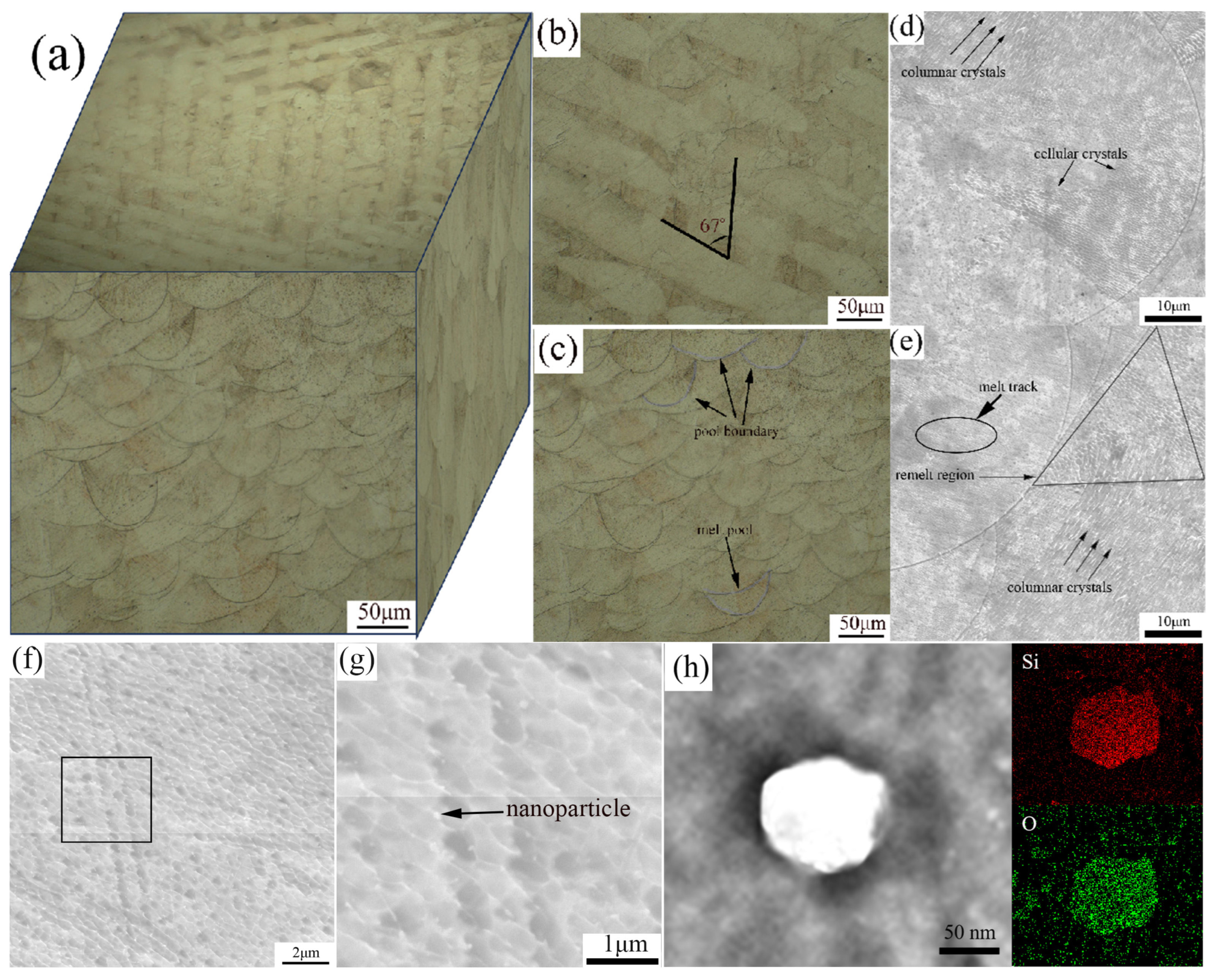
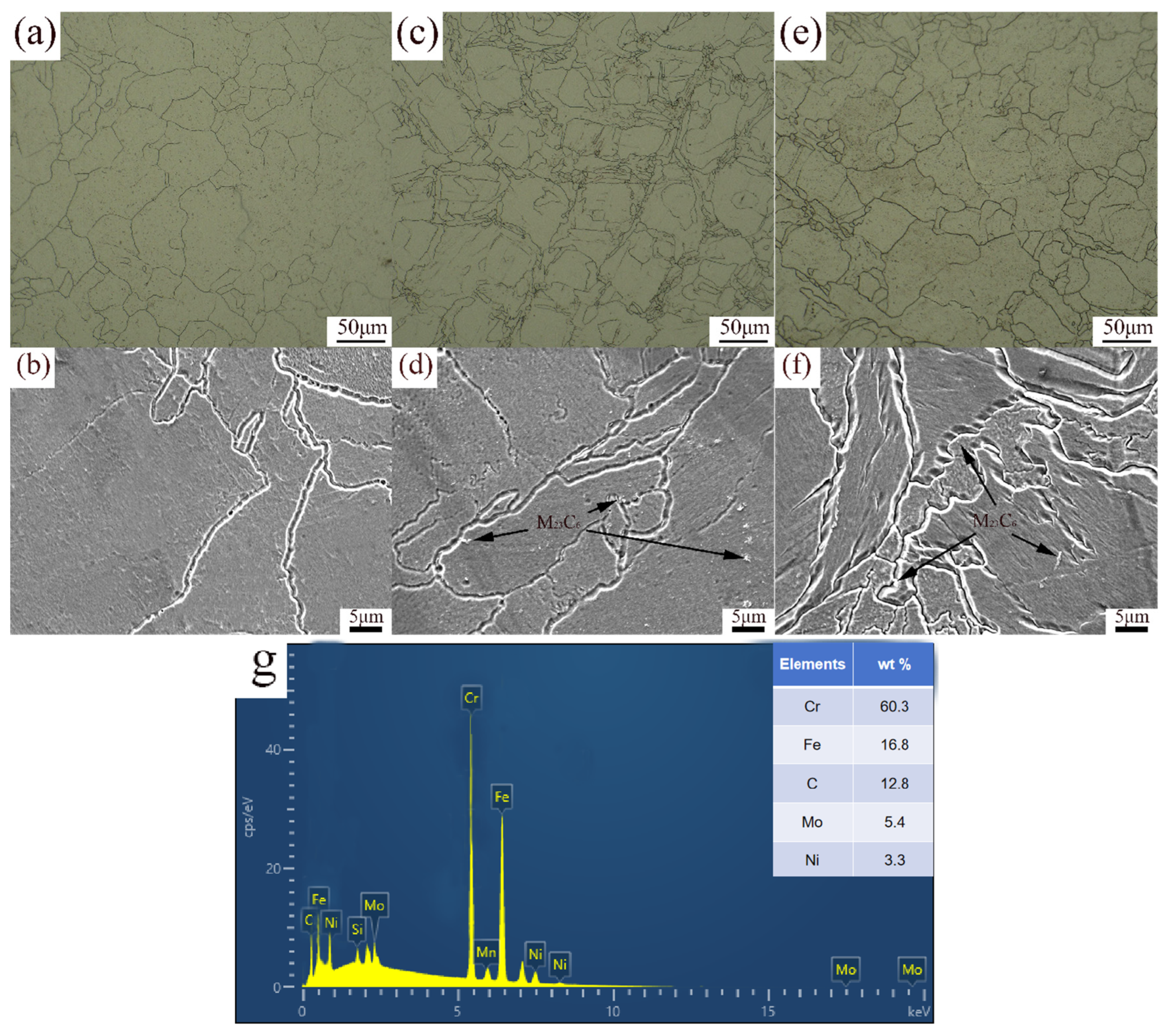



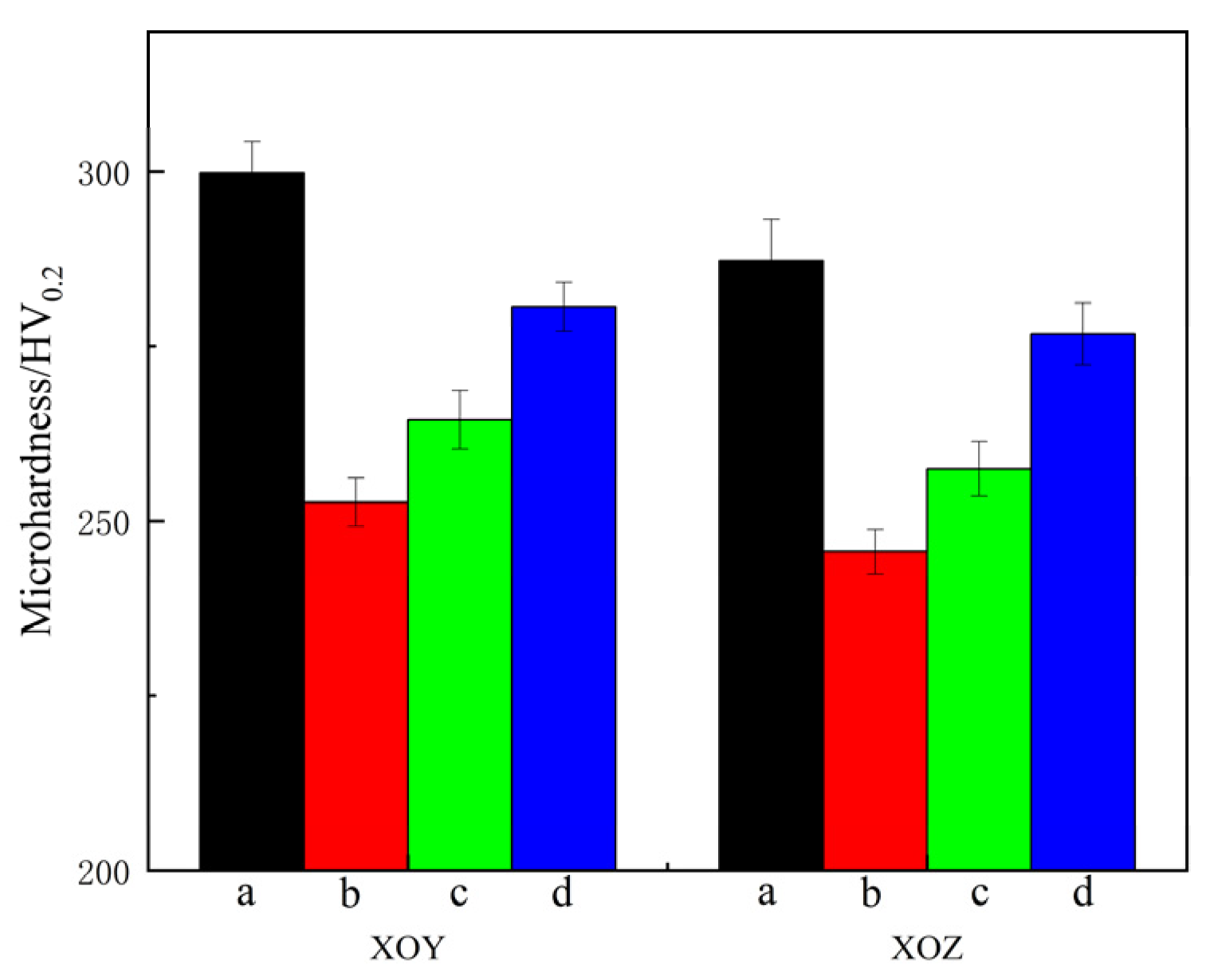
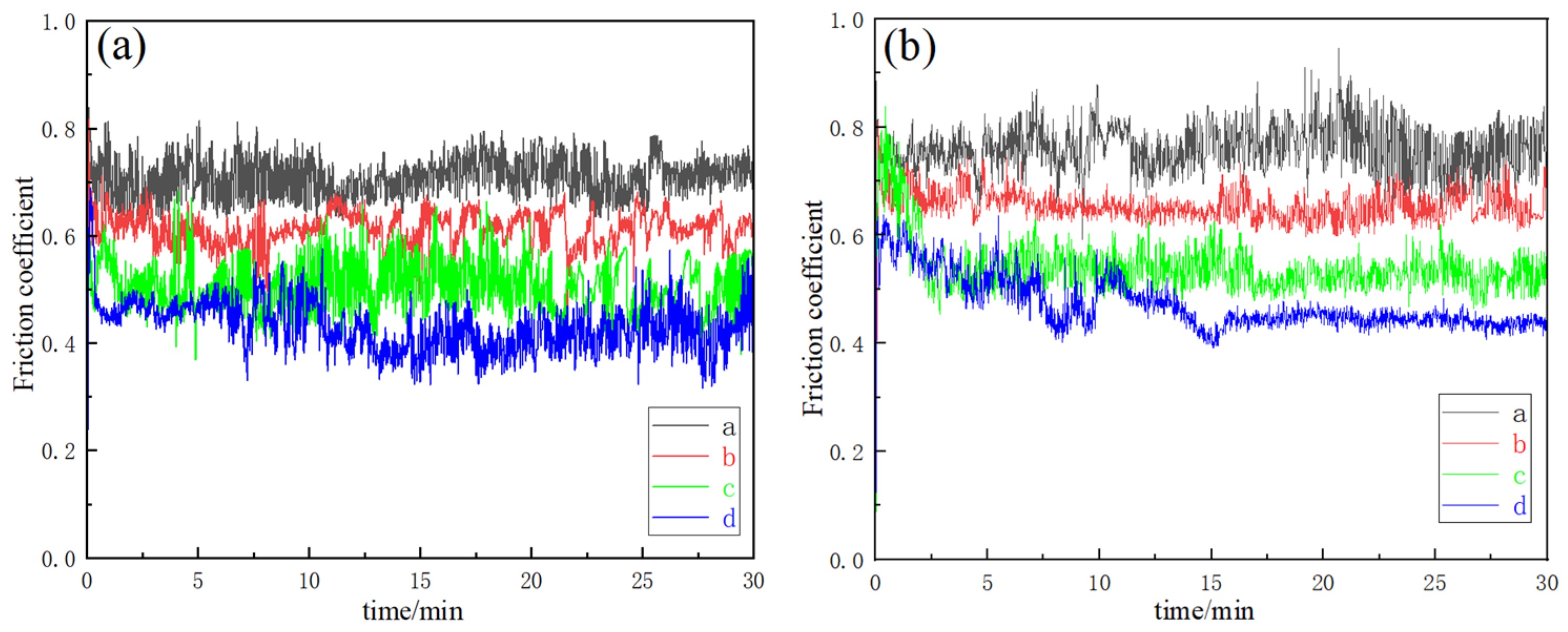

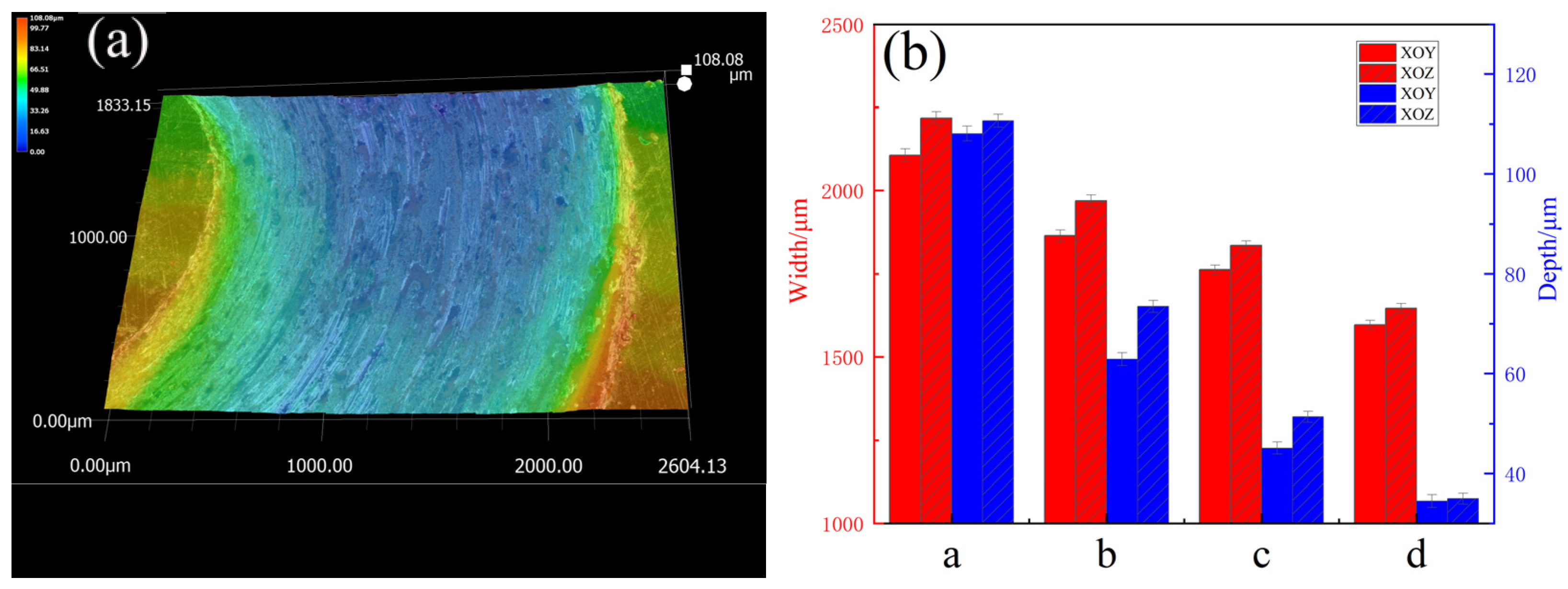

| Element | Fe | Ni | Cr | Mo | P | S | Mn | C | Si |
|---|---|---|---|---|---|---|---|---|---|
| powder | Bal. | 10.85 | 16.35 | 2.68 | 0.017 | 0.006 | 1.01 | 0.014 | 0.56 |
| a | Bal. | 11.59 | 16.89 | 2.84 | 0.021 | 0.008 | 1.13 | 0.008 | 0.49 |
| b | Bal. | 10.38 | 15.76 | 2.49 | 0.012 | 0.005 | 1.22 | 0.011 | 0.52 |
| c | Bal. | 11.39 | 15.94 | 2.53 | 0.016 | 0.007 | 1.24 | 0.009 | 0.47 |
| d | Bal. | 11.12 | 16.17 | 2.71 | 0.024 | 0.005 | 1.12 | 0.011 | 0.51 |
| Specimen | Heat Treatment |
|---|---|
| a | / |
| b | Solution treatment (1050 °C × 2 h) |
| c | Aging treatment (850 °C × 2 h) |
| d | Solution treatment (1050 °C × 2 h) + Aging treatment (850 °C × 2 h) |
Disclaimer/Publisher’s Note: The statements, opinions and data contained in all publications are solely those of the individual author(s) and contributor(s) and not of MDPI and/or the editor(s). MDPI and/or the editor(s) disclaim responsibility for any injury to people or property resulting from any ideas, methods, instructions or products referred to in the content. |
© 2025 by the authors. Licensee MDPI, Basel, Switzerland. This article is an open access article distributed under the terms and conditions of the Creative Commons Attribution (CC BY) license (https://creativecommons.org/licenses/by/4.0/).
Share and Cite
Sun, M.; Zhang, Q.; Wu, J.; Wang, H.; Wang, X.; Zhang, H.; An, Y.; Liu, Y.; Ma, L. Anisotropic Wear Resistance of Heat-Treated Selective Laser-Melted 316L Stainless Steel. Lubricants 2025, 13, 189. https://doi.org/10.3390/lubricants13040189
Sun M, Zhang Q, Wu J, Wang H, Wang X, Zhang H, An Y, Liu Y, Ma L. Anisotropic Wear Resistance of Heat-Treated Selective Laser-Melted 316L Stainless Steel. Lubricants. 2025; 13(4):189. https://doi.org/10.3390/lubricants13040189
Chicago/Turabian StyleSun, Menghui, Qianqian Zhang, Jinxiu Wu, Hao Wang, Xu Wang, Hao Zhang, Yinong An, Yujie Liu, and Long Ma. 2025. "Anisotropic Wear Resistance of Heat-Treated Selective Laser-Melted 316L Stainless Steel" Lubricants 13, no. 4: 189. https://doi.org/10.3390/lubricants13040189
APA StyleSun, M., Zhang, Q., Wu, J., Wang, H., Wang, X., Zhang, H., An, Y., Liu, Y., & Ma, L. (2025). Anisotropic Wear Resistance of Heat-Treated Selective Laser-Melted 316L Stainless Steel. Lubricants, 13(4), 189. https://doi.org/10.3390/lubricants13040189




